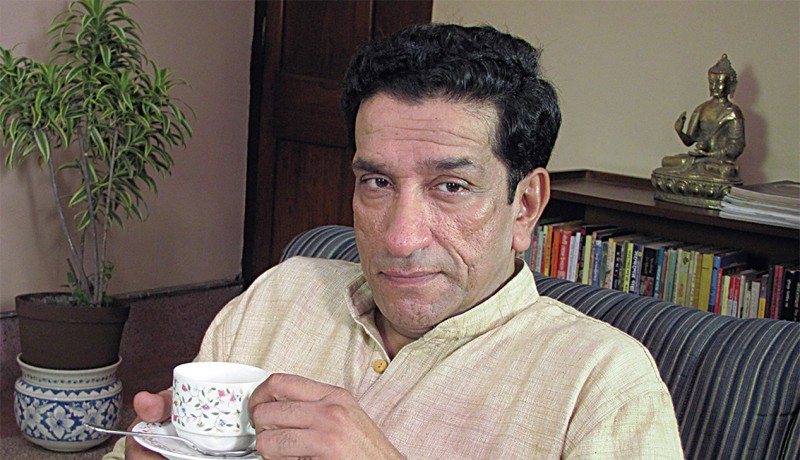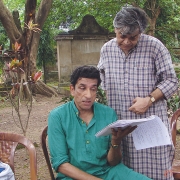
Etcetera

One of the most prolific Bengali actors, Sabyasachi Chakrabarty speaks about portraying iconic character Feluda in a freewheeling chat with Partha and Priyanka Mukherjee
When Sandip Ray decided to revive father Satyajit Ray’s Feluda on screen as a tribute to the character’s 50th year, there was much talk about who would play the iconic role. Ray played a masterstroke by bringing back Bengali actor Sabyasachi Chakrabarty to essay the role of the private investigator in his film Double Feluda. The film, which is slated for a Christmas release, is a combination of two of his father’s stories: Samaddarer Chabi (Samaddar’s Key, 1973) and Golokdham Rahasya (The Formula of Prof Dasgupta, 1980).
An actor who has mastered the craft on stage, television and the big screen, Chakrabarty lends his inimitable touch to every role he plays and wowed with his performance yet again. As he has earlier played the beloved Bengali sleuth on television, film and radio, he was an obvious favourite this time as well. What magic did he add to Double Feluda? “Well, all I tried to do was follow my director’s instructions,” is his modest reply. “I am a professional actor who believes in following the instructions of the director. Through my acting, I try to interpret his idea about the character and reach the closest possible point of his expectation.”
Tryst with acting
Chakrabarty had never dreamt of becoming an actor. “I wanted to be a technician,” he confesses. “My prime interests were camera, editing and sound recording. As I am tall, I was the boom-man in Bangla Galpo Bichitra, a 10-episode teleserial. My career in audio-visual production thus began as a boom man.”
Chakrabarty’s acting potential was noticed by his uncle Jochan Dastidar, who selected him for Gora, the lead role in Tero Parban, an adaptation of a novel by Samaresh Mazumder, in 1987. “One day, Pisemoshai [Jochan Dastidar] enquired if I owned a suit. Clueless, I arrived at the studio with a suit. He told me, ‘Put yourself in it; do your hair and say your lines as marked in the script.’ I followed his instructions and rattled off my lines in front of the camera,” he recalls. This was his initiation into the world of acting. With a stellar performance in Tero Parban, Chakrabarty made his debut in the Bengali teleserial scene with aplomb.
Then Feluda happened
In the late 1980s, Chakrabarty met Satyajit Ray and expressed his desire to play Feluda. “The director didn’t want to make another Feluda film as he thought no one could replace the late Santosh Dutta for the role of Jatayu. However, he suggested I meet his son Sandip, who might have a plan. I pursued Babu Da [Sandip Ray] until he called me in 1995,” shares Chakrabarty.
He made his acting debut with Sandip Ray’s Bakso Rahashya, Ray Junior’s first Feluda production, the first telefilm in a series he went on to create. He later played the iconic character on both celluloid and the small screen, including 10 telefilms (1996-2000) based on Feluda novels and six feature films, including Double Feluda.
Then came other projects, like Uranchandi, Sei Somoy, Khali Jahajer Rahasya, Ekaki Aroney and Ganer Oparé, which only cemented his acting prowess. Chakrabarty’s acting style also drew the attention of filmmakers across the country. His career spans 121 Bengali movies, 67 Bengali serials, 36 Bengali telefilms, 40 Bengali plays, eight Hindi movies, 12 Hindi serials, four Hindi telefilms, two English movies and a Kannada movie.
The making of Feluda
Before playing Feluda, Chakrabarty discussed the character with actor Soumitra Chatterjee, who had played the character earlier. “However, I never emulated the legend- ary’s actor’s style,” he points out. “Ray clearly said I should forget how my predecessor had portrayed the character and apply my own thinking.” Chakrabarty says he tried to make the character unique with the help of his expressions. Citing the example of Royal Bengal Rahasya, he explains, “There’s a scene where Feluda enters a dilapidated house without any idea about what could be inside. I expressed myself through my eyes; my walk, accompanied with the rustling of feet amid a deafening silence, which helped build suspense.”
The man essaying the role of Feluda is 60 in real life. However, as Feluda was 27 in the first story, Feludar Goyendagiri (1965), and remains evergreen even after 50 years, Chakrabarty had to undergo a drastic change in his appearance to portray the character. “To play the character, I had to follow a strict health regimen to shed weight so I looked younger. Feluda’s signature costume helped support the illusion.”
All in the family
Chakrabarty grew up in an affluent environment filled with art and culture. His father loved the performing arts, especially theatre, and his mother Monika Chakrabarty was co-founder of Rupantari, a group of progressive Bengali playwrights, in the early 1960s.
A lover of cricket, Chakrabarty wasn’t interested in acting or the movies as a kid. “Being a theatre enthusiast, Baba would take us out for movies but he never encouraged me to consider acting or cricket as a viable option for a career,” he says.
While his father wanted him to concentrate on formal education, the same was losing its appeal for the young boy, who was falling prey to politics at school. Eventually, he quit higher education and joined his father’s business, an X-ray machine manufacturing unit in Faridabad. This was followed by a brief stint in an interior decoration firm run by his aunt and uncle. The turning point came when he joined their audio-visual unit, Sonex.
On the personal front, Chakrabarty grew up to marry his childhood sweetheart Mithu Sanyal, daughter of an Armyman and diplomat. “Acting is a matter of attitude,” he tells us. “An actor has to study the mannerisms of people—how they react to the agonies and ecstasies in real life. Fortunately, I learnt all this from my parents who were great performers and dedicated their lives to flawless ‘acting’—the seamless portrayal of life. Now, I advise my sons Gourav and Arjun [both actors] to step out of stereotypes and explore a new world.”
Photographs courtesy: Sabyasachi Chakrabarty Featured in Harmony — Celebrate Age Magazine December 2016
you may also like to read
-
Cracking the longevity code
Small yet impactful choices can be game-changers, writes Srirekha Pillai At 102, there’s no stopping Chandigarh-based Man Kaur, the world’s….
-
Home, not alone
While a regulatory framework is vital for senior-care facilities, the need of the hour is to develop an ecosystem to….
-
Birthday Girl
Published in a special edition to honour Japanese master storyteller Haruki Murakami’s 70th birthday, Birthday Girl (Penguin; Rs 100; 42….
-
A huge treat for music lovers
Published as the revised and updated second edition, Incomparable Sachin Dev Burman (Blue Pencil; Rs. 599; 470 pages) the authoritative….








